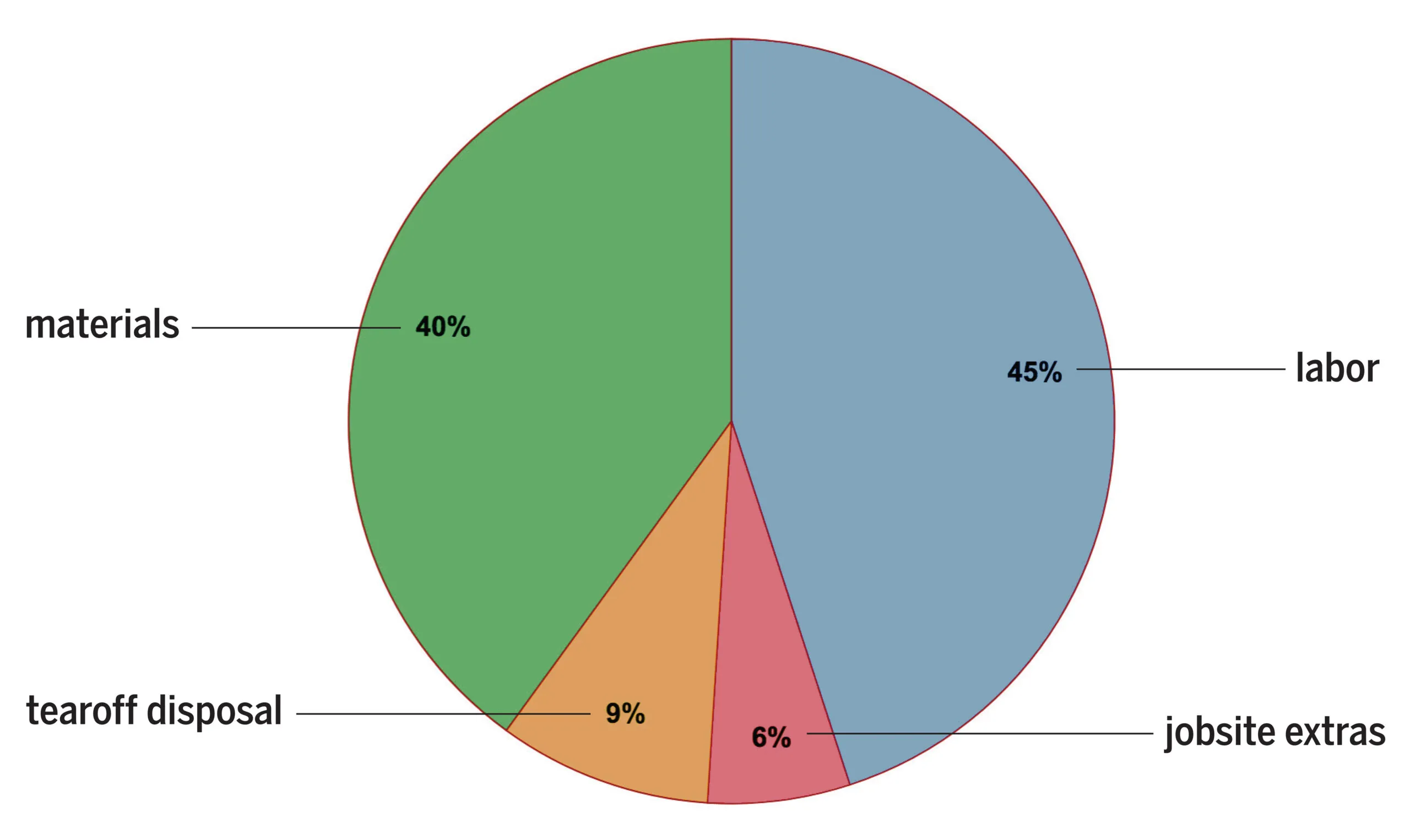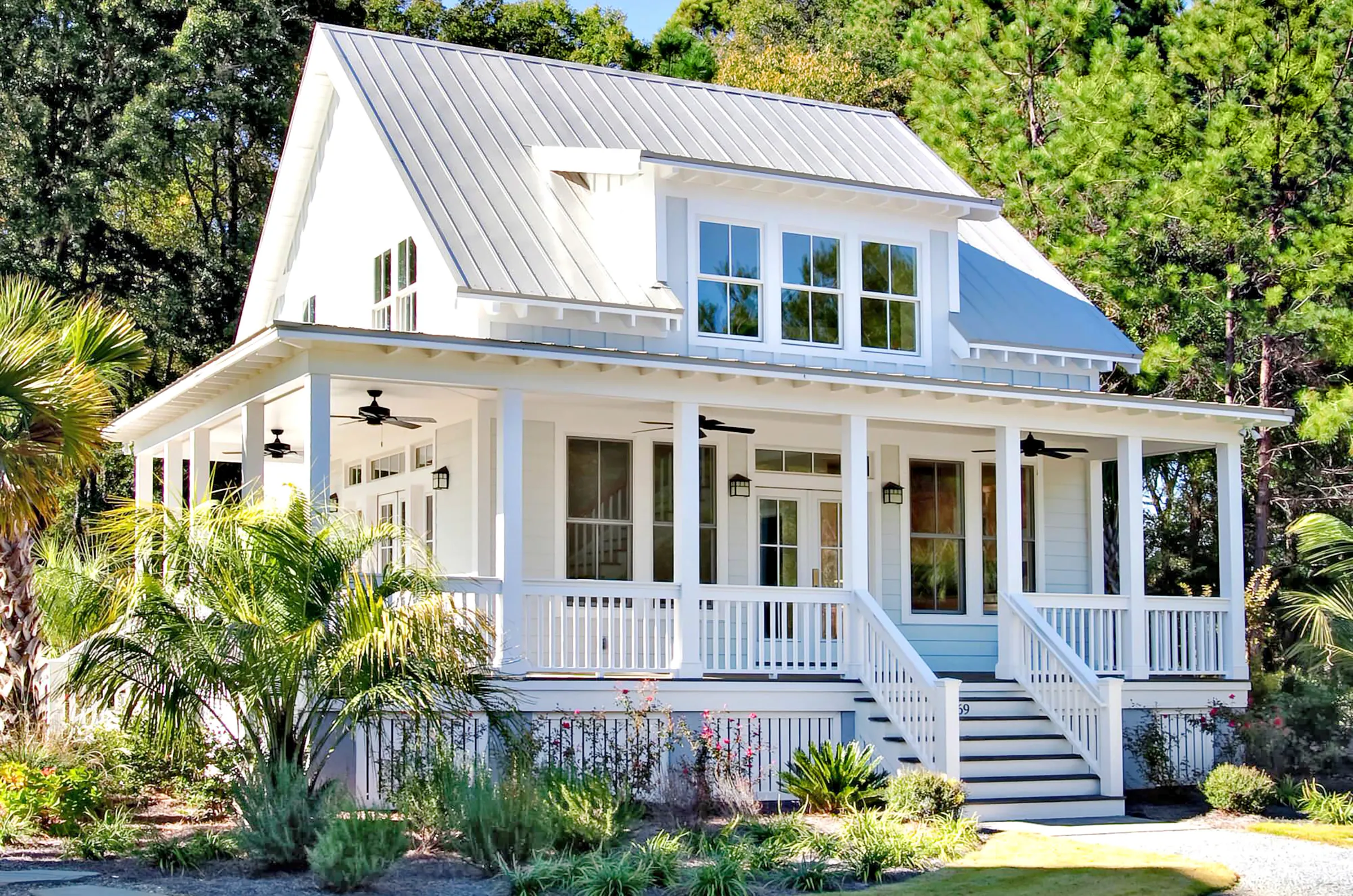Metal roofs have many advantages. They’re strong enough to survive hurricanes, hail, and wildfires. They’re durable, enjoying a life span of up to 50 years or more. They’re energy-efficient, thanks to their ability to reflect the sun’s heat. And when properly installed, they need virtually no upkeep.
If you’re considering a metal roof, this guide will tell you everything you need to know about the materials, costs, benefits, installation process, and maintenance.

Understanding Metal Roofing Materials
Metal roofing comes in a variety of materials, each with its own set of characteristics and benefits. The choice of material can significantly impact the roof’s performance, longevity, and appearance. Typical metals used for roofing include steel, aluminum, copper, and zinc. The cost of metal roofing also varies on the specific material you use.
Steel Roofing
Steel is the most popular and typically least expensive metal roofing option. It’s known for its strength and durability, often lasting for 30–50 years or more. To prevent rust, steel roofing is usually coated with zinc (galvanized) or an aluminum-zinc alloy (Galvalume), and it can also be painted to help it last longer.

Aluminum Roofing
Aluminum roofing is lighter and softer than steel, but it comes with a higher price tag. It’s an excellent choice for coastal areas or regions with acid rain due to its natural resistance to corrosion.
These roofs are almost always painted and can last for 30–50 years or more.

Copper Roofing
Copper roofs are known for their distinctive appearance and exceptional longevity, but they come at a premium price. They’re typically the most expensive metal roofing option, but they can last for 100–200 years or longer if well-maintained.
Read more: How To Build a Copper Cupola Roof

Terne Roofing
Terne, or tin, roofing is a moderately priced option that can last for 100 years or more, though it requires more maintenance than other metal roof options. Terne naturally resists the harshest conditions, never needs paint, and weathers to a uniform matte gray.

Zinc Roofing
Zinc roofing is gaining popularity due to its natural weather resistance and unique aesthetic appeal. It’s often used in high-end architectural designs. These roofs develop a bluish-gray patina over time and can last for 80–100 years.

Benefits of Metal Roofs
Metal roofs offer numerous advantages over traditional roofing materials like asphalt shingles. Understanding the pros and cons of metal roofs can help you make an informed decision about whether a metal roof is right for your home.
Read more: Metal vs. Asphalt Roof
Longevity and Durability
One of the most significant advantages of metal roofs is their exceptional lifespan. On average, metal roofs can last 40–70 years and sometimes significantly longer, depending on the material used and the quality of installation. That compares with asphalt shingle roofs that typically last 15–30 years.
This longevity is due to a metal roof’s ability to withstand extreme weather conditions, including hurricanes, hail, and wildfires. Metal roofs are also resistant to rot, insects, and mildew, further contributing to their durability.
Energy Efficiency of Metal Roofing
Metal roofs can save you money on cooling. During peak hot weather months, metal roofs reflect solar radiant heat rather than absorbing it. Even dark-colored metal roofs can meet the EnvironPA’s Energy Star criteria thanks to new heat-reflective paint pigments. This indicates that in sunny regions, energy savings from metal roofing can be significant.
Aesthetic Versatility
Modern metal roofing products come in a wide variety of styles, colors, and finishes, making them suitable for almost any architectural design. They can mimic the appearance of wood shakes, slate, clay tiles, and even asphalt shingles. This versatility allows homeowners to enjoy the benefits of metal roofing without compromising on their home’s aesthetic appeal.
Drawbacks of Metal Roofs
While metal roofs offer numerous benefits, it’s important to consider potential drawbacks before making a decision.
Initial Cost Considerations of Metal Roofing
The biggest drawback of metal roofs is their upfront cost. Metal roofing materials and installation are typically more expensive than traditional asphalt shingles. Metal roofs cost $7–$20 per square foot, which is two to six times the cost of an asphalt roof. However, it’s important to consider the long-term value and potential savings over the roof’s lifespan.
Potential for Noise
A common concern about metal roofs is that they may be noisy during rain or hailstorms. While this can be true for poorly installed metal roofs, a properly installed metal roof with adequate insulation and underlayment shouldn’t be significantly louder than other roofing materials.
Denting and Damage Concerns
Metal roofs are highly durable, but they can be susceptible to denting from large hailstones or falling branches. The likelihood of denting depends on the type and thickness of the metal used. Softer metals like copper and aluminum are more prone to denting than steel. However, many metal roofing products now come with warranties against denting and impact damage.
Installation Process for Metal Roofs
Installing a metal roof is a complex process that requires skill and precision. Understanding the basic steps can help you appreciate the importance of hiring a qualified professional for the job.

You can expect an experienced metal roofing installer to follow these steps.
Preparing the Roof Deck
The preparing the roof deck. This typically involves removing the old roofing material, inspecting the sheathing for damage, and making any necessary repairs. While some metal roofing systems can be installed over existing shingles, a full tear-off is often recommended to ensure the integrity of the roof structure.
Laying Underlayment and Slip Sheets
After the roof deck is prepared, a waterproofing underlayment is applied to the entire roof surface. This underlayment serves as a secondary water barrier and helps seal around fastener penetrations. On top of the underlayment, slip sheets (typically rosin paper) are laid to allow the metal to expand and contract freely without damaging the underlayment.
Fastening and Sealing Techniques

The final step involves installing the metal panels or shingles. This process varies depending on the specific metal roofing system being used. For standing seam roofs, panels are attached using concealed fasteners and then seamed together using a special machine. For metal shingles or tiles, each piece is individually fastened and overlapped to create a watertight seal. Proper fastening and sealing are crucial to prevent leaks and ensure the longevity of the roof.
Metal Roofing Cost

Understanding the cost breakdown of a metal roof installation can help you budget effectively and appreciate the value of your investment. The average cost of a small steel roof is around $17,500, nearly double the cost of an asphalt roof of the same size.* However, the long-term benefits of a metal roof often outweigh the higher initial upfront cost. Below, we break down the different factors that make up this total.
Metal Roofing Material Costs
Material costs typically account for about 40% of the total roofing project cost. This percentage can increase for high-end materials like copper or zinc. The cost includes the visible metal panels or shingles and also unseen elements like underlayments, flashing, and sealants. According to Angi, prices can range from $4—$25 per square foot for materials alone, depending on the type of metal and style chosen.
Labor Expenses
Labor costs usually make up about 45% of the total project cost. This percentage could increase if your home has complicated rooflines or a lot of dormers, or if the chosen roofing style is particularly difficult to install. Professional installation, from a company such as Eerie Roofing, is crucial for metal roofing, as improper installation can lead to leaks and reduced lifespan.
Long-Term Savings With a Metal Roof
While the initial cost of a metal roof is higher, it’s important to consider the long-term savings. Metal roofs can last two to three times longer than traditional asphalt shingles, reducing the need for replacement. Additionally, their energy efficiency can lead to significant savings on heating and cooling costs over time. A metal roof may also increase your home’s resale value.
*We calculated cost information in this article using RSMeans data from Gordian™. RSMeans is a construction cost database used by thousands of contractors to generate their project pricing.
Maintenance and Care for Metal Roofs
One of the advantages of metal roofs is their low maintenance requirements. However, some basic care can help ensure your roof’s longevity and performance.
Routine Roof Inspections
Regular inspections are crucial for catching any potential issues early. It’s recommended to inspect your metal roof at least once a year, preferably in the spring or fall. Look for any signs of damage, loose fasteners, or sealant deterioration. Pay special attention to areas around chimneys, vents, and other roof penetrations where leaks are most likely to occur.
Cleaning Procedures
While metal roofs don’t typically require frequent cleaning, occasional washing can help maintain their appearance and performance. Use a soft-bristled brush or a pressure washer on a low setting to remove dirt, debris, and any algae growth. Avoid using harsh chemicals that could damage the roof’s finish. If you live in an area with high pollen or near trees that drop a lot of leaves, you may need to clean your roof more frequently.
Addressing Minor Repairs
Most metal roofs require little to no repairs over their lifetime if properly installed. However, if you notice any issues during your inspections, it’s important to address them promptly. This might include resealing around roof penetrations, tightening loose fasteners, or touching up any scratches in the finish to prevent rust. For more significant repairs or if you’re unsure about how to address an issue, it’s best to consult with a professional metal roofing contractor.
Environmental Impact of Metal Roofing
Metal roofing is often considered an environmentally friendly choice due to its durability, energy efficiency, and recyclability.

Recyclability of Metal Roofing
Most metal roofs are made from recycled materials and can be fully recycled at the end of their lifespan. This reduces the demand for new raw materials and minimizes waste in landfills.
Energy Conservation
As discussed earlier, metal roofs can significantly reduce energy consumption for cooling. By reflecting solar radiation rather than absorbing it, metal roofs help keep homes cooler in the summer, reducing the need for air conditioning. This not only saves energy but also reduces the strain on power grids during peak hours, contributing to overall energy conservation efforts.
Reduced Landfill Waste
Metal roofs last longer than traditional roofing materials, so they need to be replaced less frequently. This results in less waste going to landfills over time. Additionally, when a metal roof does need to be replaced, the old materials can be recycled rather than discarded, further reducing landfill waste.
Light-colored metal roofs naturally reflect more of the sun’s energy than darker ones, but thanks to new heat-reflective paint pigments, even dark-colored metal roofs can meet the EPA’s ENERGY STAR criteria.
To find high-performing roofing, go to the Cool Roof Rating Council’s database. Look for products with a Solar Reflective Index (SRI) of 29 or more. The higher the SRI, the cooler a roof will stay.
Comparing Metal Roofs To Other Materials
To make an informed decision about the best roof for your home, it’s helpful to compare metal roofs with other common materials. Each type of roofing has its own advantages and disadvantages.
Metal vs. Asphalt Shingles
Asphalt shingles are the most common roofing material in the United States because they’re affordable and easy to install. However, metal roofs offer several advantages over asphalt:
- Longevity: Metal roofs last 2-3 times longer than asphalt shingles.
- Energy efficiency: Metal roofs reflect more solar heat, reducing cooling costs.
- Durability: Metal roofs are more resistant to extreme weather conditions.
- Environmental impact: Metal roofs are recyclable, while asphalt shingles often end up in landfills.
The main advantage of asphalt shingles is their lower upfront cost. The average cost of a 2,000-square-foot asphalt roof runs around $8,926, compared to $17,521 for the same-sized steel roof.*
Metal vs. Tile Roofing
Tile roofing, whether clay or concrete, is known for its distinctive appearance and durability. Compared to tile, metal roofing offers the following benefits:
- Lighter weight: Metal roofs put less stress on the home’s structure.
- Easier installation: Metal roofing is typically quicker and easier to install than tile.
- Wider variety of styles: Metal can mimic the look of tile while offering more color options.
However, tile roofing may last slightly longer and may provide better insulation. The cost of tile roofing is comparable to more expensive metal roofing, but may be cheaper than steel roofs, ranging from about $24,120—36,880 for a 2,000-square-foot roof.
Metal vs. Slate Roofing
Slate is prized for its natural beauty and exceptional longevity. When comparing metal to slate, metal roofs offer these advantages:
- Lighter weight: Metal is significantly lighter, making it suitable for a wider range of structures.
- Wider variety of styles: Metal offers more color and style options.
- Lower cost: Metal is typically less expensive than slate.
Slate can last even longer than most metal roofs (100+ years) and offers a unique, high-end appearance. Slate roofing costs can range from $24,113 —$37,226 for a 2,000-square-foot roof, making it one of the most expensive roofing options.
Choosing the Right Metal Roof for Your Home
You’ll need to consider several factors to pick the right metal roof for your home. Here’s what to keep in mind when making your decision.
Climate
Your local climate plays a crucial role in choosing the right metal roof. In coastal areas with salt air, aluminum or copper might be better choices due to their corrosion resistance. For areas with heavy snowfall, standing seam metal roofs are often recommended as they allow snow to slide off easily. In hot, sunny climates, light-colored metal roofs with high solar reflectance can significantly reduce cooling costs.
Architectural Style Matching
Metal roofs come in a wide variety of styles and can complement almost any architectural design. For traditional homes, metal shingles that mimic the look of slate or wood shakes might be appropriate. Modern or contemporary homes often pair well with standing seam metal roofs. Consider the color and finish too—a weathered copper look might suit a historic home, while a sleek, matte black could enhance a modern design.
Budget
While metal roofs generally cost more than most other roofing materials, there’s still a range of choices to fit different budgets. Steel roofing is typically the most affordable metal option, while copper and zinc are at the higher end of the price spectrum. Remember to consider long-term costs: A more expensive metal roof might save money over time through increased energy efficiency and reduced maintenance needs.
Debunking Common Metal Roof Myths
Despite their growing popularity, metal roofs are still subject to several misconceptions.

Myth: Metal Roofs Attract Lightning
One persistent myth is that metal roofs attract lightning. In reality, metal roofs are no more likely to be struck by lightning than any other type of roof. Lightning typically strikes the highest point in an area, regardless of the material. Moreover, if lightning does strike a metal roof, the metal disperses the energy safely throughout the structure, reducing the risk of fire compared to other roofing materials.
Myth: Metal Roofs Generate Excessive Heat
Another common misconception is that metal roofs make homes hotter in the summer. In fact, the opposite is true. Metal roofs typically reflect more solar radiation than they absorb, helping to keep homes cooler. Most metal roofs include an air gap between the metal and the roof deck, which provides additional insulation. As a result, homes with metal roofs can actually be cooler than those with traditional asphalt shingles.
Myth: Metal Roofs Rust and Corrode
Some people worry that metal roofs will rust or corrode over time. While this was a concern with older metal roofing systems, modern metal roofs are designed with protective coatings and finishes that prevent rust and corrosion. Steel roofing is typically galvanized or coated with a zinc-aluminum alloy, while aluminum and copper roofs naturally resist corrosion. With proper installation and maintenance, rust and corrosion are not significant concerns for today’s metal roofs.
Our Conclusion
Metal roofing are durable, energy efficient, and stylish, making them a great option for your home. Though they cost more upfront than some traditional roofing materials, the long-term benefits often justify the investment. With proper installation and minimal maintenance, a metal roof can protect and enhance your home for decades to come.
As with any major home improvement project, it’s crucial to do your research and consult with qualified professionals before making a decision. Consider your specific needs, local climate, home design, and budget when choosing a metal roof. By weighing all these factors, you can select a metal roof that not only protects your home but also adds to its value and curb appeal for years to come.

